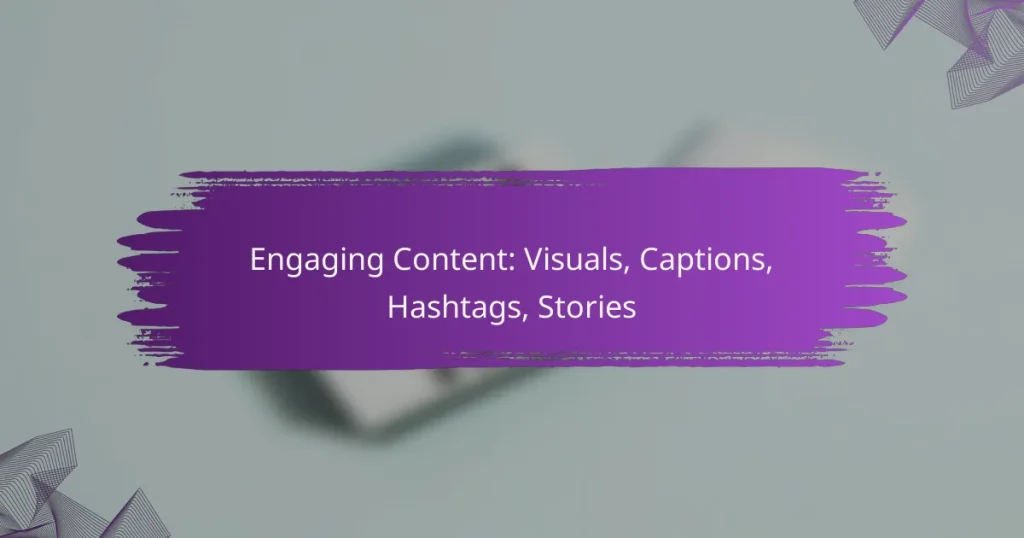Engaging content on social media is essential for capturing audience attention and fostering interaction. By utilizing high-quality visuals, compelling captions, and strategic hashtags, you can effectively convey your message and enhance your online presence. Tailoring these elements to your specific audience and platform will maximize engagement and visibility.

How to create engaging visuals for social media?
Creating engaging visuals for social media involves using high-quality images, infographics, videos, GIFs, and branded graphics to capture attention and convey messages effectively. These elements should be tailored to your audience and platform to maximize engagement.
High-quality images
High-quality images are essential for grabbing attention on social media. Aim for images that are clear, well-composed, and relevant to your content. Use professional photography or high-resolution stock images to ensure your visuals stand out.
Consider the dimensions required for each platform, as optimal sizes vary. For instance, Instagram posts typically perform best at 1080×1080 pixels, while Facebook cover photos should be 820×312 pixels.
Infographics
Infographics are powerful tools for presenting complex information in a visually appealing way. They combine graphics and text to summarize data, making it easier for viewers to understand and retain information. Use infographics to highlight statistics, processes, or comparisons.
Keep your design clean and organized, using a limited color palette and clear fonts. Tools like Canva or Piktochart can help you create professional-looking infographics without extensive design skills.
Videos
Videos are highly engaging and can convey messages more dynamically than static images. Aim for short, captivating clips that are ideally under two minutes to maintain viewer interest. Use storytelling techniques to connect emotionally with your audience.
Ensure your videos are optimized for each platform, considering factors like aspect ratio and length. For example, TikTok videos thrive on vertical formats, while YouTube supports both horizontal and vertical orientations.
GIFs
GIFs are a fun way to add movement and humor to your social media posts. They can be used to illustrate reactions, highlight key moments, or simply entertain your audience. Keep them short and relevant to your content to enhance engagement.
Use tools like Giphy or Tenor to find or create GIFs that resonate with your audience. Avoid using GIFs that are too long or distracting, as they can detract from your main message.
Branded graphics
Branded graphics help reinforce your brand identity and make your content instantly recognizable. Use consistent colors, fonts, and logos across all visuals to create a cohesive look. This consistency builds trust and recognition among your audience.
Consider creating templates for your posts to streamline the design process. Tools like Adobe Spark or Canva allow you to customize templates while maintaining brand consistency, making it easier to produce engaging content regularly.
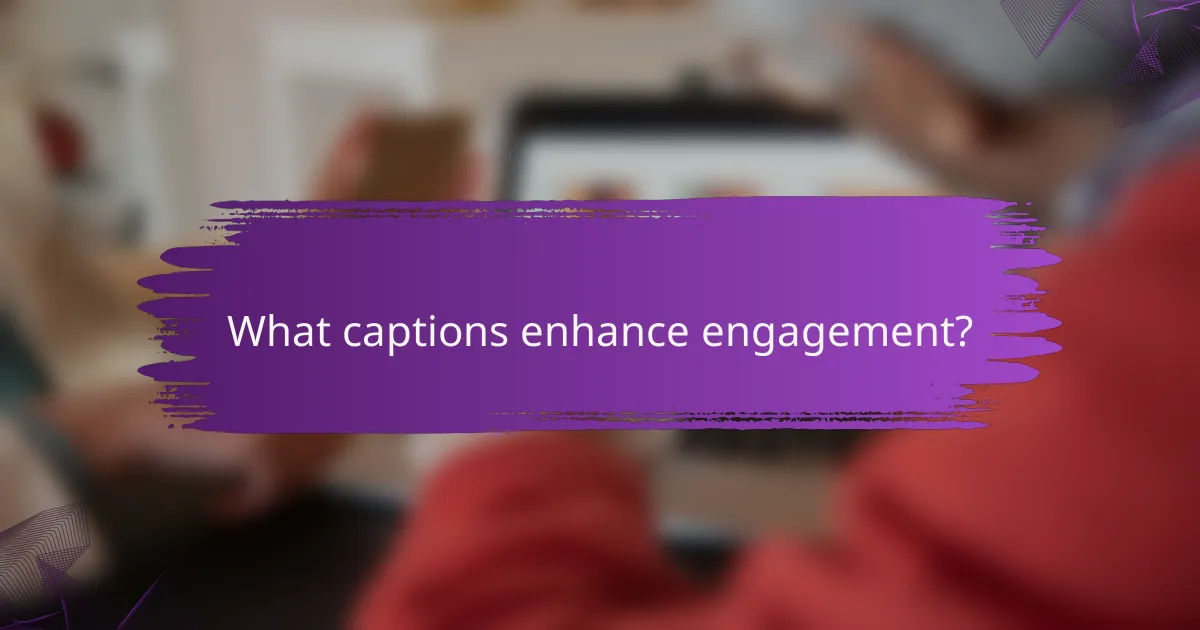
What captions enhance engagement?
Captions that enhance engagement are concise, emotionally resonant, and include clear calls to action. They draw the audience in, encourage interaction, and can significantly boost the effectiveness of visual content.
Concise and clear
Captions should be brief and to the point, ideally under 150 characters. This keeps the audience’s attention and ensures your message is easily digestible. Avoid jargon and complex language to maintain clarity.
For example, a simple caption like “Sunset at the beach” is straightforward and effective. It allows viewers to quickly grasp the content without unnecessary distractions.
Emotional triggers
Utilizing emotional triggers in captions can create a deeper connection with your audience. Words that evoke feelings such as joy, nostalgia, or excitement can encourage users to engage more with your content.
For instance, instead of saying “We had a great time,” you might say, “This moment filled our hearts with joy.” The latter is more likely to resonate emotionally and prompt likes or shares.
Call-to-action phrases
Incorporating call-to-action phrases in your captions can guide your audience on what to do next. Phrases like “Comment your thoughts below” or “Share this with a friend” encourage interaction and can lead to increased engagement.
Ensure your calls to action are clear and direct. For example, “Tag someone who needs to see this!” is an effective way to prompt users to engage with your post actively.
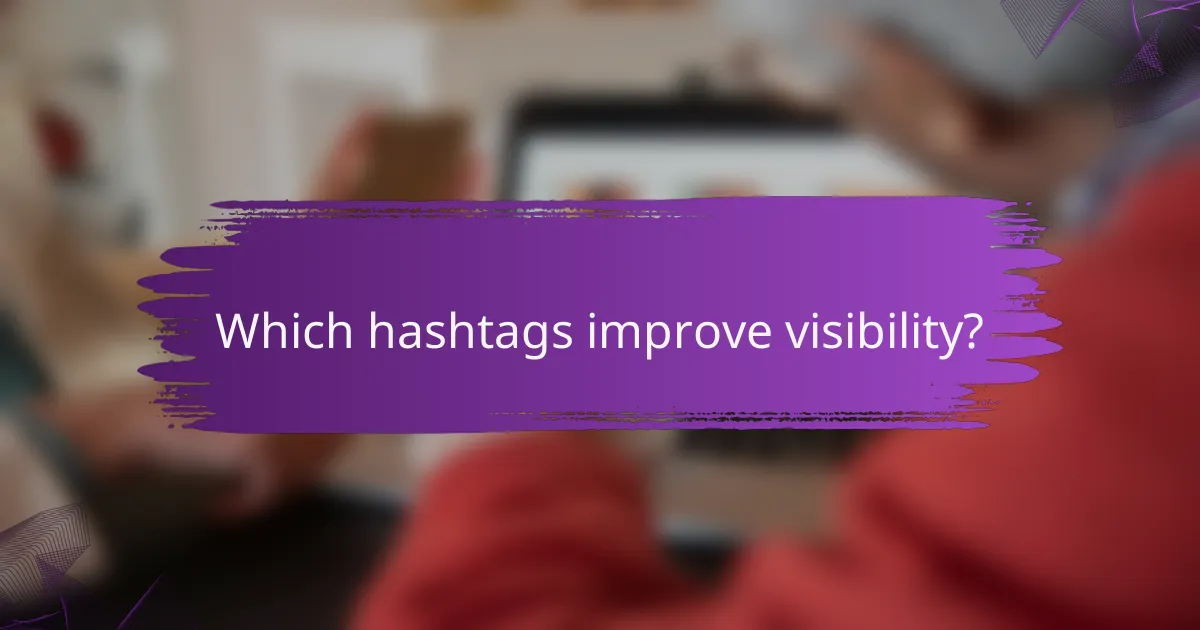
Which hashtags improve visibility?
Hashtags that improve visibility are those that are relevant, popular, and specific to your content. Using a mix of trending, branded, and location-based hashtags can significantly enhance your reach and engagement on social media platforms.
Trending hashtags
Trending hashtags are those currently popular on social media, often tied to current events or viral topics. Utilizing these hashtags can increase the likelihood of your content being discovered by a broader audience. Tools like Twitter Trends or Instagram’s Explore page can help identify these hashtags.
When using trending hashtags, ensure they are relevant to your content to avoid appearing disingenuous. A good practice is to limit the number of trending hashtags to a few that align closely with your message.
Branded hashtags
Branded hashtags are unique to a specific brand or campaign, helping to create a recognizable identity. They encourage user-generated content and can foster community engagement around your brand. Examples include Nike’s #JustDoIt or Coca-Cola’s #ShareACoke.
To create effective branded hashtags, keep them short, memorable, and easy to spell. Promote them consistently across your marketing channels to build awareness and encourage their use among your audience.
Location-based hashtags
Location-based hashtags target specific geographic areas, making them ideal for local businesses or events. These hashtags can connect you with nearby users and enhance local visibility. Examples include #NYCEats for New York City restaurants or #LondonFashion for fashion events in London.
When using location-based hashtags, combine them with general hashtags to maximize reach. Research local trends and popular tags to ensure your content resonates with the community you are targeting.
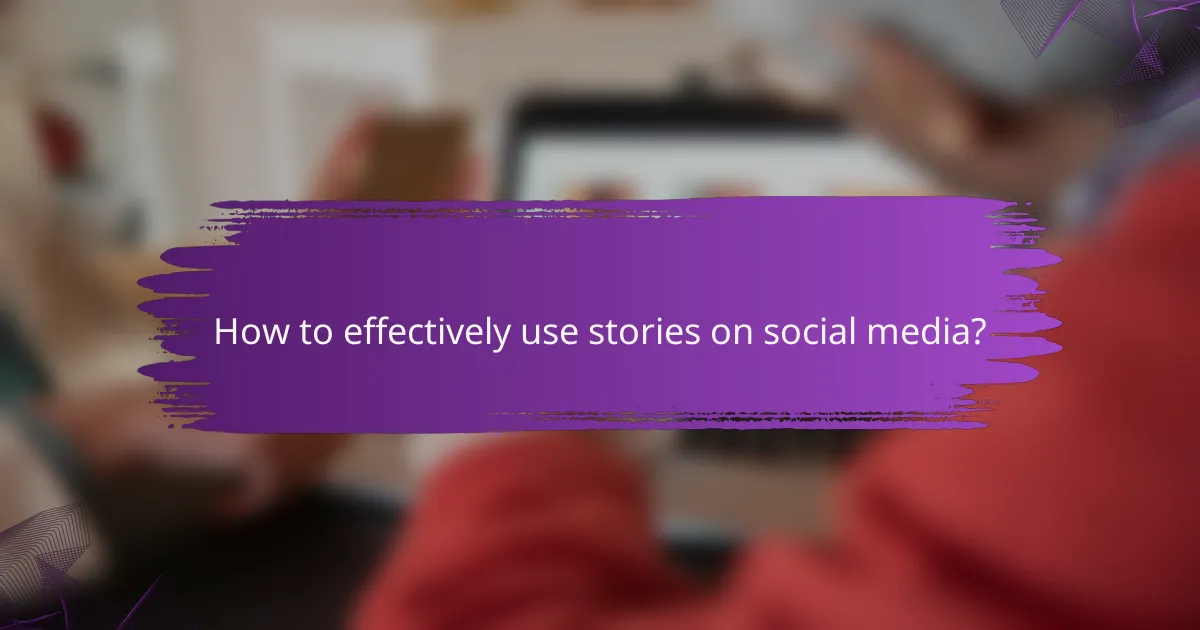
How to effectively use stories on social media?
To effectively use stories on social media, focus on engaging your audience through interactive and visually appealing content. Stories should be short, impactful, and encourage viewer participation to enhance connection and retention.
Interactive polls
Interactive polls are a great way to engage your audience by inviting them to share their opinions. You can create polls on topics relevant to your brand or industry, which not only boosts interaction but also provides valuable insights into your audience’s preferences.
Consider using simple yes/no questions or multiple-choice formats to keep it straightforward. Aim for polls that can be answered quickly, ideally in a few taps, to maintain viewer interest and participation.
Behind-the-scenes content
Behind-the-scenes content offers a glimpse into your brand’s daily operations, helping to humanize your business and build trust with your audience. Sharing candid moments, team activities, or the production process can create a sense of authenticity that resonates with viewers.
Use this type of content to showcase your company culture or highlight the people behind your products. Aim for a balance between professionalism and relatability to keep your audience engaged while maintaining brand integrity.
Time-sensitive promotions
Time-sensitive promotions create urgency and encourage immediate action from your audience. Use stories to announce flash sales, limited-time offers, or exclusive discounts that are only available for a short period.
Clearly communicate the promotion details, including start and end times, to avoid confusion. Incorporate countdown timers or reminders in your stories to enhance urgency and drive conversions effectively.
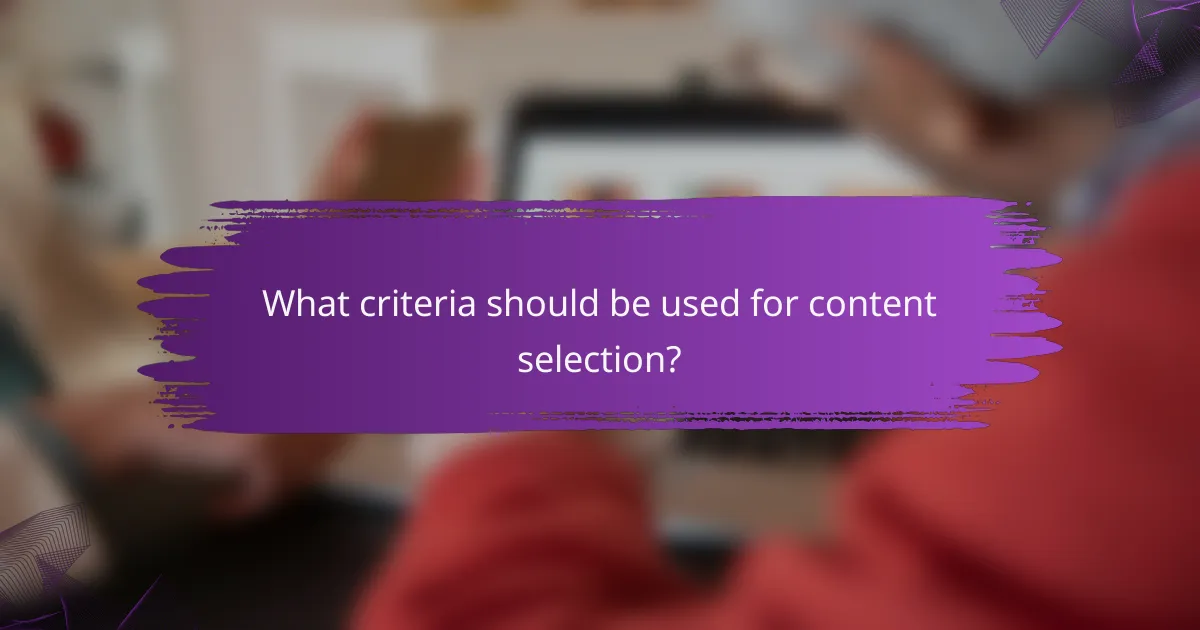
What criteria should be used for content selection?
Content selection should focus on relevance, engagement potential, and alignment with the brand’s objectives. Key criteria include understanding the target audience, adhering to platform-specific guidelines, and ensuring the content is visually appealing and informative.
Target audience preferences
Understanding target audience preferences is crucial for effective content selection. Consider demographics such as age, interests, and behaviors to tailor content that resonates. For instance, younger audiences may prefer short, engaging videos, while older demographics might favor detailed articles or infographics.
Utilizing surveys and analytics can provide insights into what types of content your audience interacts with most. Regularly reviewing engagement metrics helps refine your approach and ensures that your content remains relevant and appealing.
Platform-specific guidelines
Each social media platform has its own set of guidelines that dictate the best practices for content. For example, Instagram favors visually striking images and short captions, while LinkedIn is more suited for professional articles and industry insights. Understanding these nuances can significantly enhance content performance.
Additionally, be aware of platform-specific algorithms that prioritize certain types of content. For instance, videos often receive higher engagement on Facebook and TikTok, while Twitter thrives on concise text and timely updates. Adhering to these guidelines can improve visibility and engagement rates across platforms.
